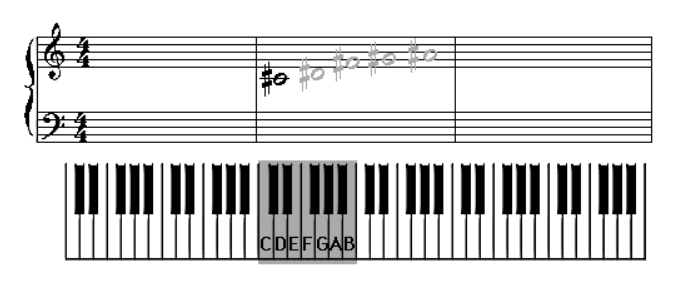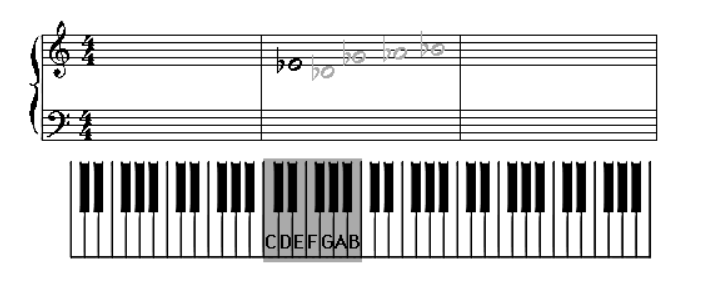
Starter Studies
Lesson 2 - Section 1
Learning About Black Keys
Welcome to lesson number Two. In lesson number one you learned how to find “C” on the piano and to locate middle C. You also learned the other notes on the white keys. Now it’s time to learn about the black keys.
The notes on a piano are divided into Half Steps. Locate middle C. Now move up the keyboard (to your right) to the first black key. The distance between middle C and the first black key is 1 half step. Now move up the keyboard, from the black key, to the next white key (which is “D“). The distance between that black key and “D” is 1 half step.
The reason we are learning this, is to build a foundation for you to learn about Sharps and Flats. The names of the black notes will end with the word sharp or flat.
Now, go to “E” on the keyboard. Move up the keyboard from “E” to “F.” The distance between “E” and “F” is also 1 half step. This can be confusing since you are not moving from a black key to a white key. To clear up the confusion, just remember that any time you are moving from one key to the next (which includes the black keys), you are moving 1 half step.
This is all you need to learn here. The point is to learn how to move 1 half step.

Lesson 2 - Section 2
Learning About Sharps
Now that you have learned half steps you are ready to learn about Sharps.
The word Sharp is like shorthand in typing. It’s a short hand way of saying that you are to move 1 half step up the keyboard.
As an example, go to middle C on the keyboard. Move up to the first black key (1-half step). You are now on the Sharp of “C.” Another way of saying this is that you have Sharped “C.”
Hence, the name of this black note is C Sharp. Now go to “G” and move up 1 half step to the nearest black key. The name of this black key is G Sharp.
Whenever you see the symbol “#” on the staff next to a note, it means that the composer wants you to play a note that is 1 half step up from the note he or she has shown on the staff. Let’s look at how that is written on the staff. Go to the next section.

Lesson 2 - Section 3
More About Sharps
Look at middle C on the staff. You’ll notice that it has a “#” sign next to it. This means that the composer wants you to play a note that is 1 half step up the keyboard from “C.”
Go to each white note within 1 octave and locate all the Sharped notes. There are five total (1 for each black note). Their names are:
C# – D# – F# – G# – A#
You are done. Congratulations. You have now mastered Sharps.
Before you go on to the next section, I need to clear up another confusing issue. All the black keys have two names. As you have just learned, they have a Sharp name. In the next section of this lesson, you will learn that they also have a Flat name. Don’t worry. This is not difficult once you see what a Flat is.

Lesson 2- Section 4
Learning About Flats
Now that you have learned Sharps you are ready to learn about Flats. This is the black note’s other name.
The word Flat is also like short hand in typing. It’s a short hand way of saying that you are to move 1 half step down the keyboard.
As an example, go to “E” on the keyboard. Move down (left) to the first black key (1-half step). You are now on the Flat of “E.” Another way of saying this is that you have Flatted “E.”
I think of it as bending the note downward to make the note sound lower or trying to flatten it. And, sharping the note makes the note sound higher.
Hence, the name of this black note is E Flat. Now go to “A” and move down 1 half step to the nearest black key. The name of this black key is A Flat.
Whenever you see the symbol “b” (looks similar to a lowercase b) on the staff next to a note, it means that the composer wants you to play a note that is 1 half step down from the note he or she has shown on the staff. Let’s look at how that is written on the staff. Go to the next section.

Lesson 2 - Section 5
More About Flats
Look at “E” above middle C on the staff above. You’ll notice that it has a “b” sign next to it. This means that the composer wants you to play a note that is 1 half step down the keyboard from “E.”
Go to each white note within 1 octave and locate all the Flatted notes. There are five total (1 for each black note). Their names are:
Db – Eb – Gb – Ab – Bb
You are done with this lesson. Congratulations! You have now mastered Flats.
Quick Review
“C” Sharp is the same black note as “D” Flat
“D” Sharp is the same black note as “E” Flat
“F” Sharp is the same black note as “G” Flat
“G” Sharp is the same black note as “A” Flat
“A” Sharp is the same black note as “B” Flat
This # symbol stands for Sharp and this b symbol stands for Flat.
Remember to practice at least 15 minutes every other day until you start to play and practice songs. Practice by looking at your keyboard and identifying the name of each note as you play it and hear how it sounds. Also remember that each black note has two names (and some white notes too). How about a quiz to check your progress?
Click or Tap to take Quiz


No comments:
Post a Comment